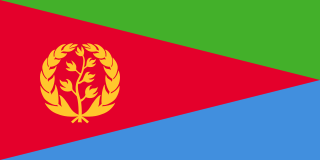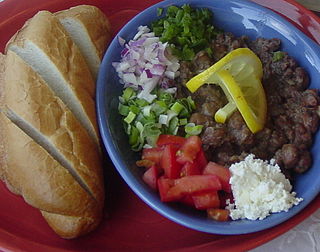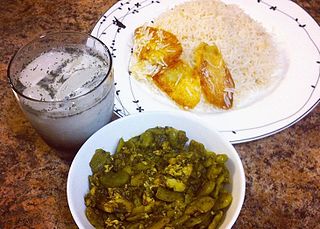Fava may refer to:
- Vicia faba , a leguminous plant whose beans are also known as broad beans or fava beans.
- Fava (Greek dish), a puree made of split peas.
- Fava (Turkish dish), a puree made of fava beans.
Fava may refer to:

Falafel is a deep-fried ball or patty-shaped fritter of Egyptian origin, featuring in Middle Eastern cuisine, particularly Levantine cuisines, and is made from broad beans, ground chickpeas, or both.

Vicia faba, commonly known as the broad bean, fava bean, or faba bean, is a species of vetch, a flowering plant in the pea and bean family Fabaceae. It is widely cultivated as a crop for human consumption, and also as a cover crop. Varieties with smaller, harder seeds that are fed to horses or other animals are called field bean, tic bean or tick bean. Horse bean, Vicia faba var. equinaPers., is a variety recognized as an accepted name. This legume is very common in Southern European, Northern European, East Asian, Latin American and North African cuisines.

Pease pudding, also known as pease porridge, is a savoury pudding dish made of boiled legumes, typically split yellow peas, with water, salt and spices, and often cooked with a bacon or ham joint. A common dish in the north-east of England, it is consumed to a lesser extent in the rest of Britain. In Newfoundland, it retains its traditional name as part of the customary Jiggs dinner. In non-English speaking countries, similar dishes exist under different names.

Eritrean cuisine is based on Eritrea's native culinary traditions, but also arises from social interchanges with other regions. The local cuisine, despite featuring influences of both the Ottoman and Italian cuisines, shares similarities with the cuisine of neighboring Ethiopia and the cuisines from other African countries in the region.

Ful medames, or simply fūl, is a stew of cooked fava beans served with olive oil, cumin, and optionally with chopped parsley, garlic, onion, lemon juice, chili pepper and other vegetables, herbs, and spices. Ful medames is traditionally made in and served out of a large metal jug. It is notably a staple food in Egypt and is considered a national dish, especially in the northern cities of Cairo and Gizah. Fava beans can sometimes be also found in other cuisines in the Middle East, and Africa, though cooked differently.

A purée is cooked food, usually vegetables, fruits or legumes, that has been ground, pressed, blended or sieved to the consistency of a creamy paste or liquid. Purées of specific foods are often known by specific names, e.g., apple sauce or hummus. The term is of French origin, where it meant in Old French purified or refined.

Split peas are an agricultural or culinary preparation consisting of the dried, peeled and split seeds of Pisum sativum, the pea.

Shahan ful, simplified to ful, is a dish common in Sudan, South Sudan, Somalia, Ethiopia and other parts of the Horn of Africa, which is generally served for breakfast. Believed to originate from Sudan, it is made by slowly cooking fava beans in water. Once the beans have softened, they are crushed into a coarse paste. It is often served with chopped green onions, tomatoes, and hot green peppers, as well as yogurt, feta cheese, olive oil, tesmi, berbere, lemon juice, cumin, and chili pepper. It is typically eaten without the aid of utensils accompanied with a bread roll. It is popular during the Ramadan season and during the various Lents.

The cuisine of Bahrain consists of dishes such as biryani, harees, khabeesa, machboos, mahyawa, quzi and zalabia. Arabic coffee (qahwah) is the national beverage.

Bean dip is a type of dipping sauce made using beans or refried beans as a primary ingredient. It is typically served with tortilla chips, and can also be served with other foods such as crackers and crudités. Various types of beans are used, and fresh-cooked, canned or flaked beans can be used. Various additional ingredients are used in its preparation, such as onion, garlic, chili peppers and spices, and it is sometimes garnished with some ingredients. Bean dip can be served cold, at room temperature, or hot. Bean dip is sometimes used as an ingredient in the preparation of other dishes such as burritos and quesadillas.

Lathyrus clymenum, also called Spanish vetchling, is a flowering plant in the family Fabaceae, native to the Mediterranean. The seeds are used to prepare a Greek dish called fava santorinis. The plant is cultivated on the island of Santorini in Greece and was recently added to the European Union's products with a Protected Designation of Origin.

Baghali ghatogh is a northern Iranian dish made with fava beans, dill, and eggs. It's usually served with kateh in northern provinces such as Gilan and Mazandaran, and can be considered a khoresh. It is spiced with turmeric, salt, garlic, and sometimes pepper.

Maccu is a Sicilian soup and also a foodstuff that is prepared with dried and crushed fava beans and fennel as primary ingredients. Several dishes exist using maccu as a foodstuff, such as bruschetta al maccù and maccu di San Giuseppe, the latter of which may be served on Saint Joseph's Day in Sicily.
Bissara, bessara, besarah, bayssara, bayssar and tamarakt is a dish in Egyptian cuisine and Moroccan cuisine. The dish contains split fava beans, onions, garlic, fresh aromatic herbs and spices. All ingredients are slowly cooked and then blended together to yield a creamy and fragrant dip or side dish.

Baghalaa polow ; is an Iranian dish of rice, fava beans and dill. In Persian, baghalaa means fava bean while polo is pilaf, a style of cooked rice. It is made by cooking rice and green broad beans in boiling water. When cooked, the rice and beans are layered with dill in a pan, and everything is baked in an oven until ready. Saffron water can also be added to the rice. It is typically served with meat. Like other Iranian traditional foods, the dish may be served at special occasions and family gatherings.

Fava, also known as bakla ezmesi, is a traditional Turkish dish made of dried fava beans, which are soaked and dehulled, leaving the deeper green split inner seeds. These are boiled, typically with onion, until very soft, mixed with salt, pepper, sugar, lemon juice and olive oil, and pureed. The resulting paste is chilled until it sets and can be cut into cubes. This dish is served cold, sprinkled with olive oil and chopped dill.

Fava (φάβα), in Greek cuisine, is a traditional dish made of split peas, typically yellow ones. They are cooked with chopped onion and mashed together with seasonings, garlic, lemon juice and oil into a thick, creamy paste. The dish can be eaten as such, warm or cold, but is also often used as a dip, much like hummus.